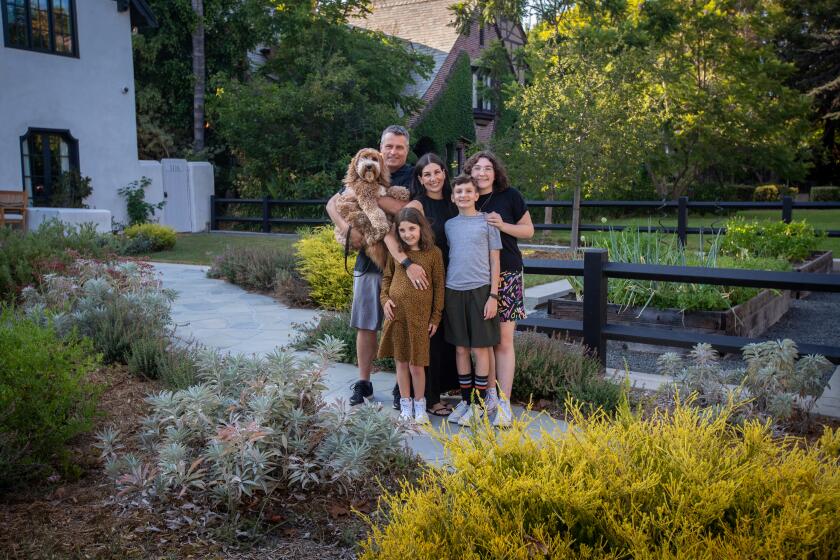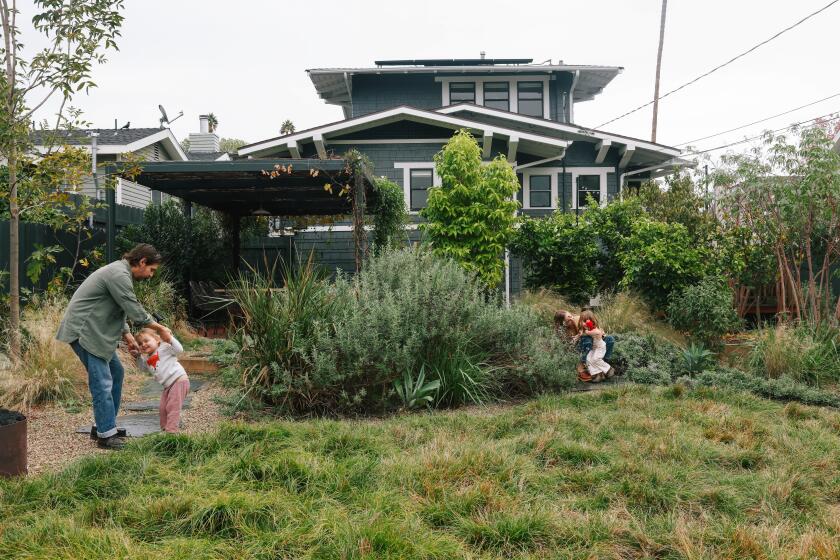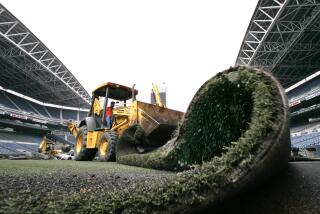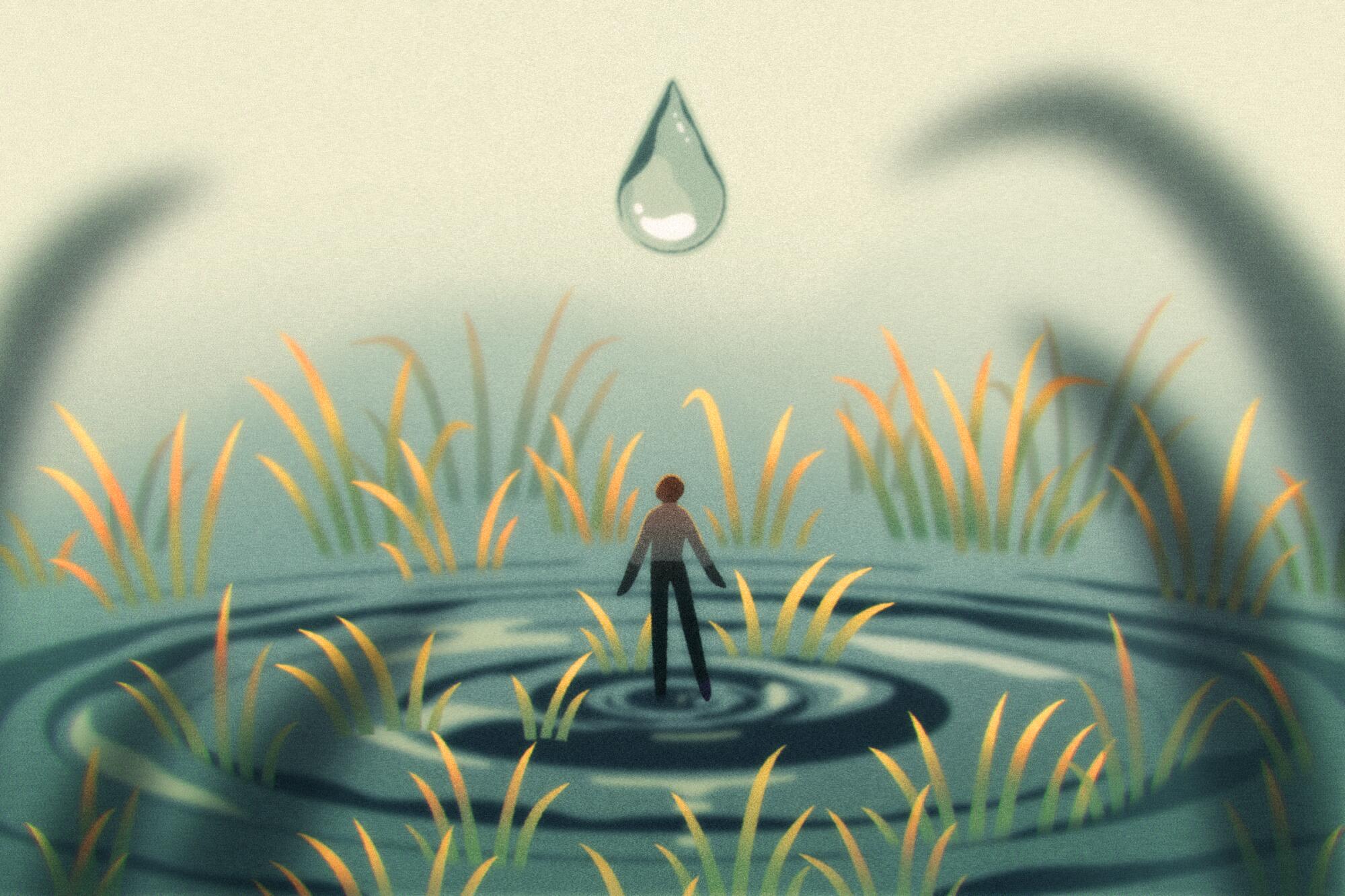
- Share via
Rip it all out, she said. Every blade of grass, frontyard and back. As soon as my wife heard the city was offering a rebate, she wanted to replace our lawns with bark mulch and bunchgrass.
“We’ll save on the water bill,” she said. “And we’ll help the environment.”
I had my doubts. What would neighbors think about disrupting the procession of tidy, green rectangles that defined our block? What about resale value? Would our dog miss her old backyard?
My wife frowned.
The ensuing debate lasted for weeks, a back-and-forth revived by each new report of drought and water restrictions. It has left me with an essential question: Is there any such thing as a guilt-free lawn in L.A.?

The Los Angeles Department of Water and Power provides about 91 billion gallons of water to residential customers each year. While much of that is used for drinking, cooking and washing, as much as half goes to grass, plants and trees, according to estimates. That’s 45 billion gallons.
Even with last winter’s rains and Southern Californians cutting back during the drought, the specter of future dry spells and a dwindling Colorado River have bolstered the case for altering the way we landscape in a Mediterranean climate.
Grass — or turf — is not only thirsty, it forces out native plant life and demands chemical treatments that leak into the sewer system. Was there anyone out there who might make a case for staying green?
Don Hodel, an environmental horticulturist and emeritus advisor for the University of California, began his response to that question with a disclaimer: “I know it’s not popular to say you want a lawn anymore.”
But Hodel proceeded to suggest we think twice before making any big changes. Turf has unique benefits, he said. It lures us outdoors, encourages us to recreate and measurably cools the air on hot summer afternoons.
They renovated their Los Angeles yard with climate change in mind. Then they got derailed by a Nextdoor complaint and a city notice.
Hodel also has a slightly different view of the math. Of the water designated for domestic and business use in California, an estimated 80% goes to agriculture as compared to about 20% for urban uses.
“I’m not against water conservation,” he said. “It’s just that lawns are functional in many respects and I don’t think we save that much, overall, by getting rid of them.”

As an environmental historian, Ted Steinberg takes the long view of residential lawns. He starts by describing his own yard.
“From across the street, it looks relatively similar to the perfectly green lawns of my neighbors,” said the author of “American Green: The Obsessive Quest for the Perfect Lawn.” “But when you get closer, you find a lot of different species of grasses … what some people call weeds.”
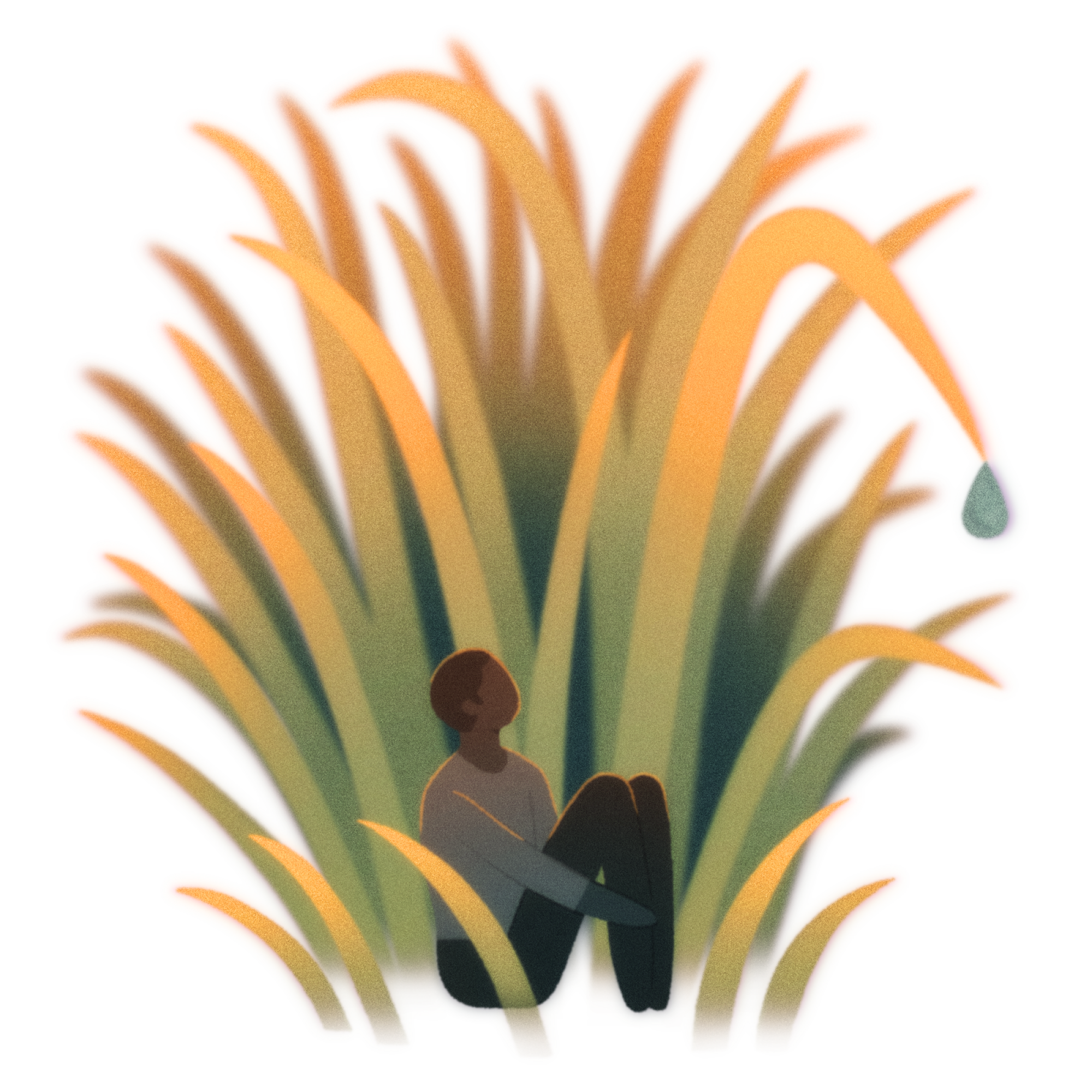
Therein lies a compromise. Steinberg has borrowed from early American history, when lawns were haphazard at best, often blending grass, clover and weeds. We’re talking about a time before sprinkler systems, power mowers and weed whackers. Homeowners swung an occasional scythe.
It took something drastic to elevate our landscaping tastes. It took World War II.
The herbicide 2,4-D was developed as a biochemical weapon that would later be used in Agent Orange. Its effectiveness at killing weeds soon led to an array of lawn products marketed to suburbanites in tract homes with sliding-glass doors that blurred the distinction between inside and out. Madison Avenue spent “gazillions of dollars trying to convince people of the need for luscious, green expanses.” Steinberg said.
During the pandemic, Rachel Nafis worked as an ER nurse. Burned out, she turned to flower farming and learned that being a florist is about more than just flowers.


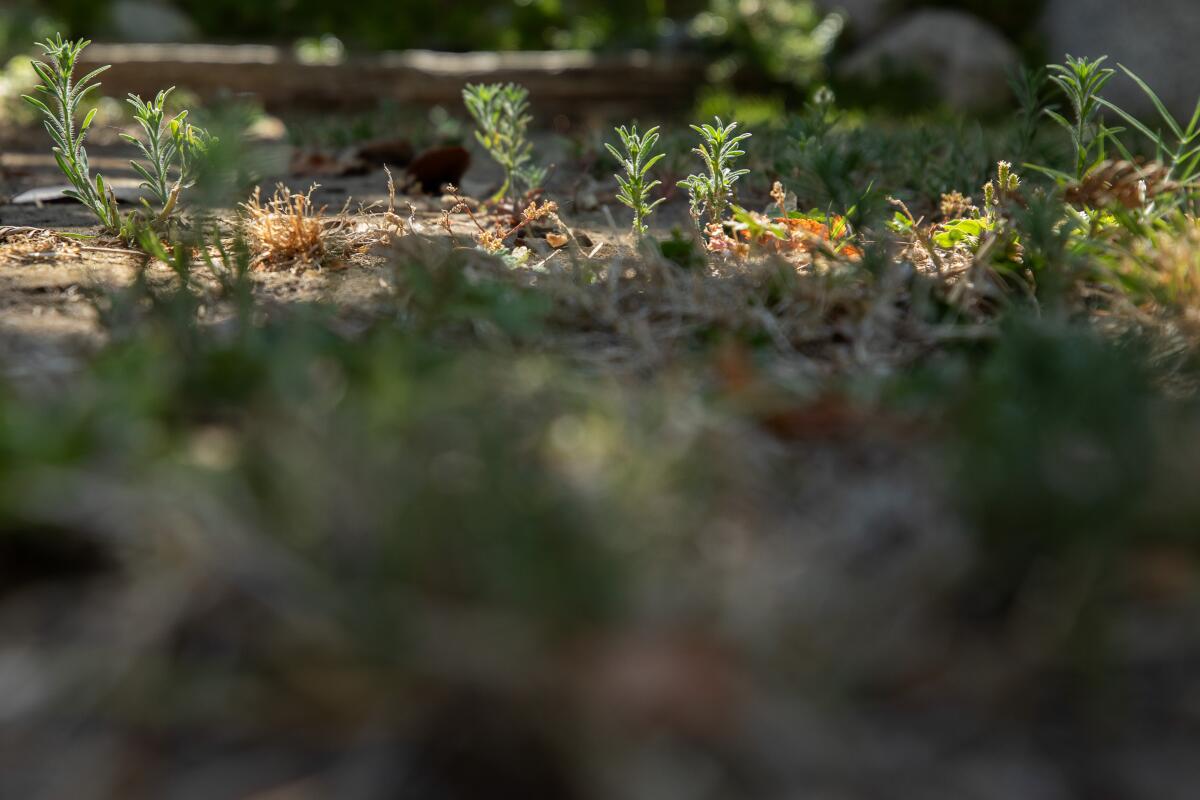
1. David Wharton had doubts about switching from grass to drought-tolerant plants. 2. Succulents grow in Wharton’s yard. 3. Wharton kept a low-maintenance grass backyard, letting things grow as they will with little irrigation. (Photos by Myung J. Chun / Los Angeles Times)
A cultural norm took root, homeowners feeling duty-bound to douse their yards with chemicals, fertilizers and water. In my case, that meant frequent visits to Home Depot to stock up for the battle against stubborn patches where grass would not grow. Steinberg suggests I was sold a bill of goods.
“I’m not anti-lawns,” he said. “My schtick is anti-perfect lawns.”

If my argument in favor of turf was gaining momentum, it hit a roadblock in the form of Alessandro Ossola. The assistant professor of plant sciences at UC Davis delivered this simple, undeniable, ecophysiological fact.
California has thousands upon thousands of species, subspecies and varieties of native plant life, he told me. Grasses — at least the kind we tend to seed, water and mow in our yards — are not among them.
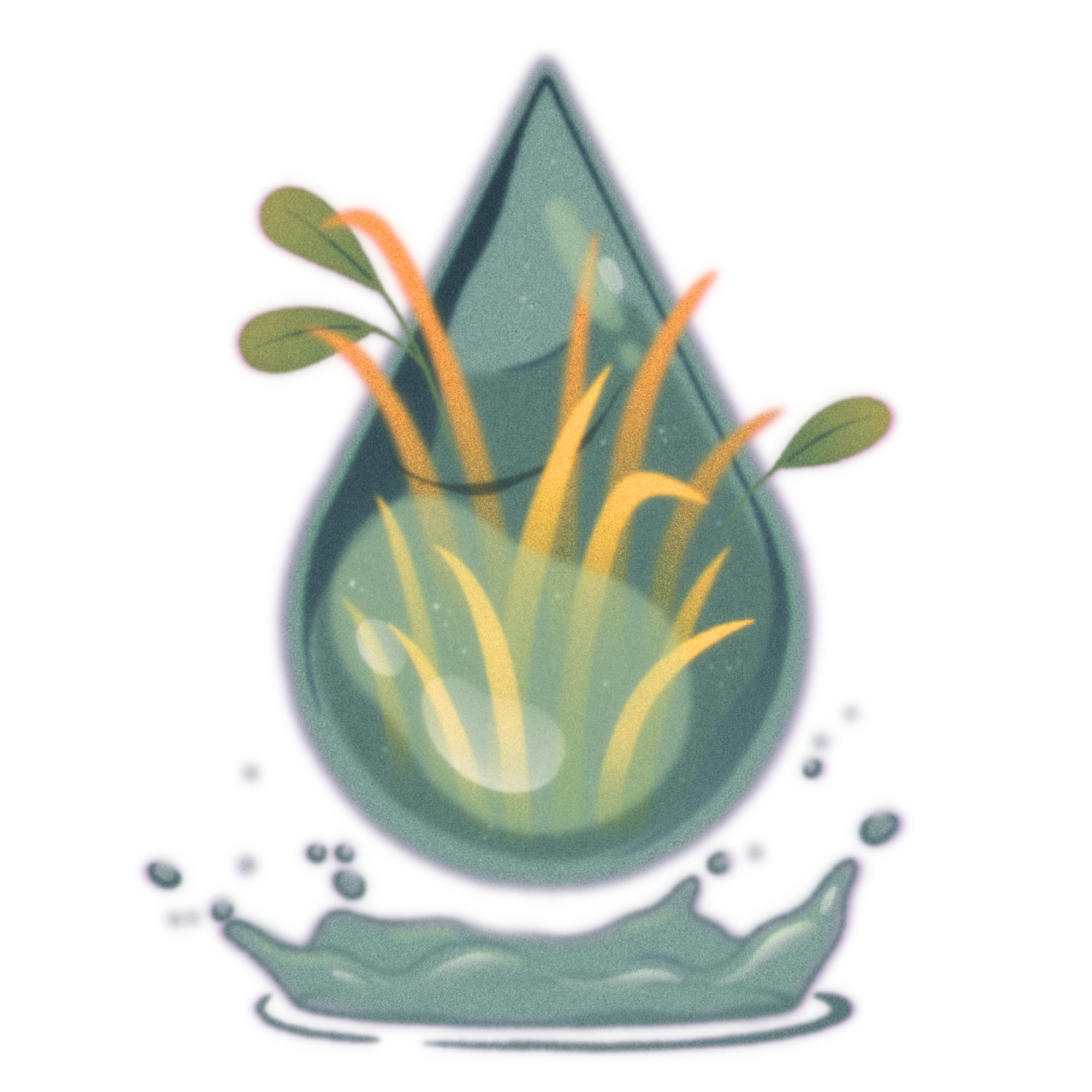
“They are completely outside the climate niche,” Ossola said. “The environment is too hot and dry.”
Native yards eliminate the need for weed killers and other chemicals that spill into gutters, winding up in the ocean. They provide a friendlier habitat for bees. Water savings can be substantial.
In Los Angeles, the rebate my wife heard about — it pays residents $5 per square foot to a maximum of $25,000 — has resulted in 53.4 million square feet of turf replaced since 2009. The LADWP estimates a savings of about 2.3 billion gallons a year, or enough to provide drinking water for 28,800 homes.
“We know the recipe,” Ossola said when talking about drought. “If we don’t change our behavior, we’re not going to win this war.”

So what happened at my house?
We tore up the frontyard, replacing it with a variety of tall grasses and low, flowering shrubs that could be sparingly nourished by a drip system. Just as my wife predicted, eliminating that 802 square feet of turf reduced our overall water usage by 10% overnight.
Not only was the new yard environmentally responsible, it actually looked nice and got compliments from the neighbors.
“Our water challenges are so significant and the opportunities are so great,” said Heather Cooley, director of research at the Pacific Institute. “I would argue that we all need to do our part.”
Kyle and Claire Penn pulled out their lawn in Eagle Rock and never looked back. “We haven’t given up anything by not being able to run around on grass,” Kyle says.
There was, however, a catch.
We kept the lawn in back. Like Steinberg, we cut back on watering and stopped fertilizing. Clover, weeds and brown spots soon appeared.
I was fine with that. So was the dog.
More to Read
Sign up for Essential California
The most important California stories and recommendations in your inbox every morning.
You may occasionally receive promotional content from the Los Angeles Times.


